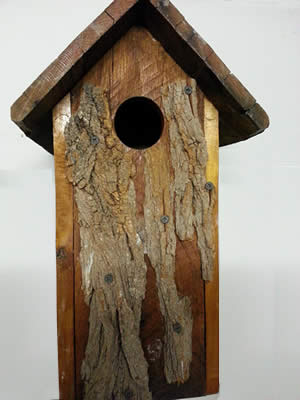Wooden Birdhouses
HOMEGROWN EXPERT GARDENING ADVICE
 Having wooden birdhouses in your flower garden brings hours of bird-watching pleasure. These tiny houses are so charming, plus they provide a sanctuary for your feathered friends while giving your outdoor surroundings a beautiful and unique décor. Here are some useful guidelines for building wooden birdhouses:
Having wooden birdhouses in your flower garden brings hours of bird-watching pleasure. These tiny houses are so charming, plus they provide a sanctuary for your feathered friends while giving your outdoor surroundings a beautiful and unique décor. Here are some useful guidelines for building wooden birdhouses:
Wooden birdhouses require a little upkeep provided that the materials used are durable that can withstand inclement weather conditions. However, do not use pressure-treated lumber as it emits vapors that are toxic to birds when it gets wet. Tin cans, metal or milk cartons are not good for nest boxes as these usually overheat and kill young birds and eggs.
Make sure nails are properly driven and not sticking through the wood as these can scratch the birds, pets or people.
It’s best to attach birdhouses to a tree, post or structure. When building birdhouses for bluebirds make sure raccoons and cats cannot reach them. Putting some perches on the birdhouse is not really necessary, except when you are housing starlings and house sparrows.
What Your Birdhouses Should Have:
Hinged side or roof – rust-proof hinges are a good choice. A hinged side or roof allows you to clean the birdhouse much easier each spring, preferably early March. Do not use hook and eye because raccoons can open it.
Roof with overhang on the front – this gives the birds two functions: first is to protect the entrance hole from wind and rain and second is to prevent cats or other animals from reaching in from the roof.
Drain and ventilation holes – Drill a 4-inch drain hole at the bottom of each birdhouse, plus two 5/8 inch ventilation holes on each side of the house.
Protective walls and floor – the side walls must enclose the floor so the birds won’t get wet when it rains. This will also prevent rain from seeping into the birdhouse, especially if a nest is built inside. Elevate the floor about half an inch from the bottom to avoid rotting caused by moisture.
Safe coat/ paint – Sand the birdhouses for a nice, smooth finish before designing them. It is okay to color the birdhouses but do not paint the inside of the house. You may use preservatives like stain or paint on the outside of the birdhouses but never use creosote as a preservative. Finish each bird house with 2 coats of external latex paint and 3 coats of polyurethrane. Take note that birds will not nest in boxes/houses that smell like humans or are painted inside.
Proper spacing – Most birds are territorial so it’s best to follow proper spacing, especially if there are nests to protect. To reduce conflicts, space birdhouses 25 feet apart, however for blue bird houses, space the houses 300 feet apart. If you are housing wood ducks, golden eye and mergansers, then you may space the houses closer together since these birds are not territorial.
Don’t fret if birds do not immediately settle in your newly built birdhouses. Birds will eventually occupy the houses after a few weeks.